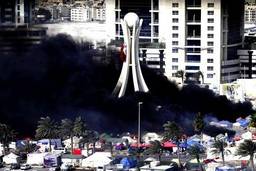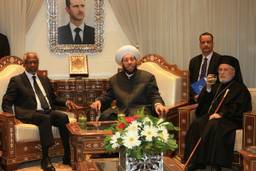On September 18, 2010 in Chicago, a Lebanese immigrant, Sami Samir Hassoun, 22, placed a backpack containing a paint can, which he thought to be a bomb, outside of a popular Wrigleyville sports bar on an especially busy Saturday afternoon. He was immediately arrested by police and FBI agents because they had known this was going to happen all along:
the FBI was onto him from the start, planting an informant and undercover agents to record Hassoun's every move. Hassoun never realized it, but the FBI provided him with the camcorder he used to scout bombing locations, paid him $2,700 so he could quit his job to work full time on his terrorism plot and gave him the phony bomb he left in the garbage bin outside Sluggers in the 3500 block of North Clark Street, according to the complaint.
So the bomb, the surveillance equipment, and the means to devote himself totally to terrorist action were all given to help Hassoun by the FBI carry out a fake terrorist attack.
Reading the government’s complaint against Hassoun, the case seems more like a tragic farce than a serious security threat.
In 2009, the FBI asked a “cooperating source” (CS) to approach Mr. Hassoun at Hassoun’s work and befriend him. In the summer of 2010, Mr. Hassoun began to share with the CS that he wanted to plan some kind of terrorist attack. At this point, the CS began recording all of their conversations and, by the end of July, had introduced Hassoun to two undercover FBI agents—UC-1 and UC-2—who represented themselves as sympathetic to Hassoun’s ideas.
However, the image of Hassoun that is revealed in the complaint is not one of a fanatical jihadist. Hassoun’s main interests are clearly self-aggrandizement, money, embarrassing Mayor Daley, and a ‘revolution’ which will place ‘some of our guys in’ power. When UC-2 asked him how he could take over the city with terrorist attacks:
Hassoun answered: ‘I have no clue.’ Later, however, Hassoun explained that they could assume control of Chicago by cultivating a replacement mayoral candidate whom they could buy off and manage.
Hassoun’s lack of ideology prompted UC-2 to try to goad Hassoun into a response by mentioning UC-2’s anger at the way the U.S. treats Arabs around the world. In response Hassoun explained his reasons for the proposed attack were “ ‘…kind of a different concept than that.’ Hassoun saw attacking Chicago as a means of creating chaos to gain political control of the city and its sources of revenue.”
There is absolutely no evidence in the government’s complaint that Hassoun had any connection with any terrorist organization—or that Hassoun was even religious. Instead Hassoun saw groups like Al-Qaeda as possible patsies to blame his attacks on to throw the police off his trail.
Clearly, Hassoun had no regard of civilian life in proposing his attacks, some of which were doomsday scenarios like poisoning the city’s water supply or dispersing Ricin at the Daley Center. Still, Hassoun’s idea of a terrorist attack seems more inspired by Die Hard With a Vengeance than jihad.
What’s more troubling is that the case of Sami Samir Hassoun is not the first time the FBI have used informants and provided material aid to would-be terrorists in order to arrest them when they attempt to carry out their half-baked schemes.
In June 2006, 7 men from the impoverished Liberty City neighborhood of Miami were arrested for planning an attack on the Sears Tower and government buildings in Florida. These men were described as ‘home-grown terrorist network’ linked to a ‘radical Black Muslim group’ in the media.
However, reading the complaint filed by the government, the men simply do not seem capable of the crimes they were plotting. They were all black men of Haitian descent who lived in an abandoned warehouse and practiced an idiosyncratic religion, which they called Islam, but more closely resembled the teachings of the Moorish Science Temple.
Without the man known to them as an “Al-Qaeda representative”, they wouldn’t have been able to rent the cars and purchase surveillance equipment needed to begin their plans.
Another similar case is that of four men, led by James Cromitie, who plotted to blow up at least one synagogue in New York and shoot down an Air National Guard Jet in New Jersey in May 2009. The confidential witness who aided and abetted the would-be terrorists was a Pakistani immigrant named Shaheh Hussein. Hussein, who had been previously granted political asylum in the US, had been arrested previously for helping someone get a driver’s license illegally. He agreed to work for the FBI in 2007 in exchange for not serving any jail time and receiving an extension of his green card status.
Hussein introduced himself to James Cromitie as a member of the Pakistani terrorist group Jaish-e-Mohammed. After a series of meetings, Hussein provided the men with fake weapons—a Stinger missile that would not fire and 3 fake IEDs. After the men planted their fake bomb outside of a synagogue, they were arrested by the FBI who’d been watching them all along.
Reading all of this, you can't help but wondering if stings like these are even a good way to defend against terrorism. Targeting individuals with no link to terrorist groups doesn’t seem like a good way to discover any actionable intelligence. All of the men seem at least a little naïve and at worst unbalanced. Would any of these men even have developed to planting a bomb somewhere, if they hadn’t been supported, socially and economically, by government agents?
The cases here are a clear sign of America’s overreaction to 9/11. As citizens we need to hold our leaders and media accountable for sensationalizing stories like that of Hassoun. Otherwise we will never be able to get working on the real problems our country is facing.
Please consider supporting our work.

I hope you found this article important. Before you leave, I want to ask you to consider supporting our work with a donation. In These Times needs readers like you to help sustain our mission. We don’t depend on—or want—corporate advertising or deep-pocketed billionaires to fund our journalism. We’re supported by you, the reader, so we can focus on covering the issues that matter most to the progressive movement without fear or compromise.
Our work isn’t hidden behind a paywall because of people like you who support our journalism. We want to keep it that way. If you value the work we do and the movements we cover, please consider donating to In These Times.



